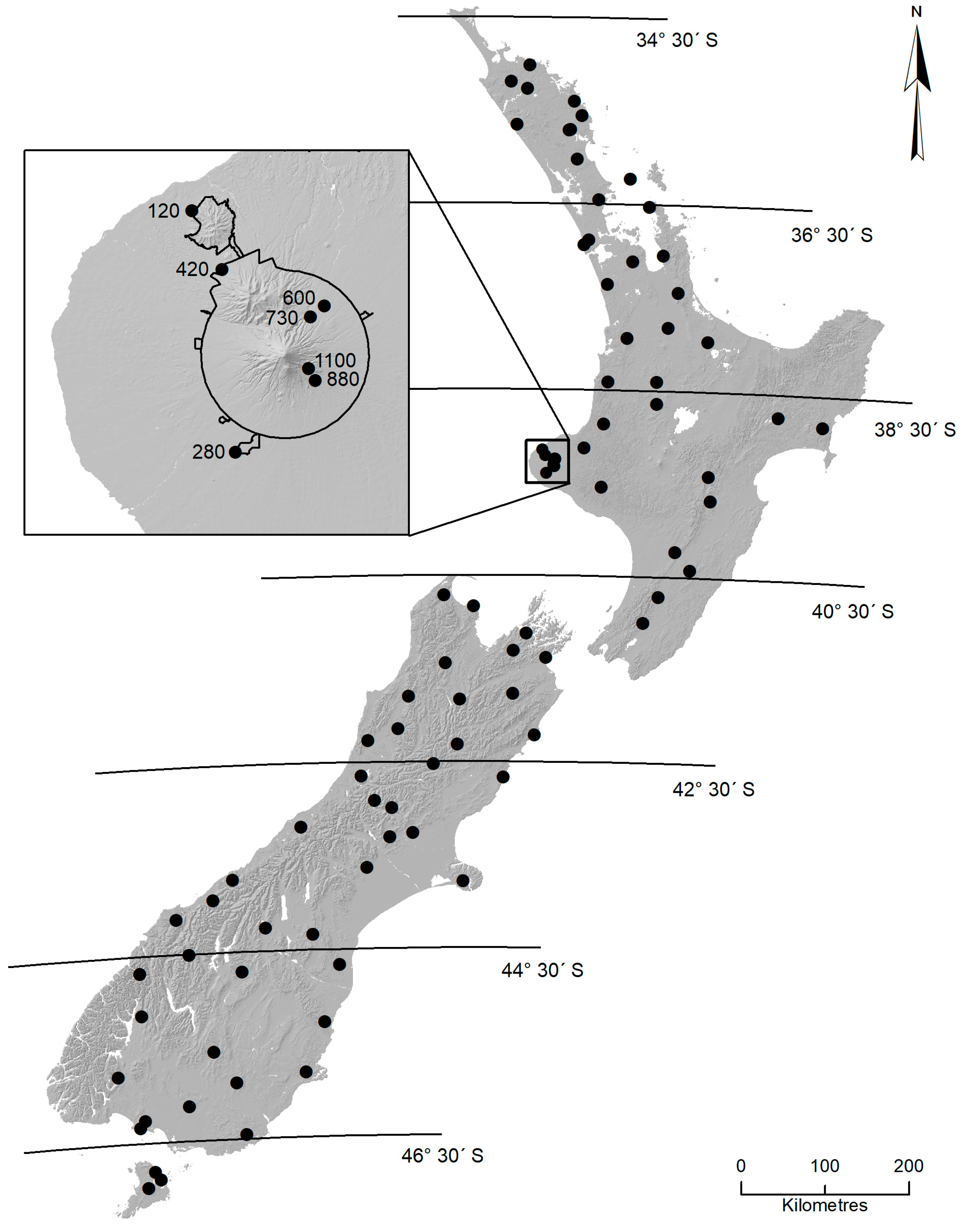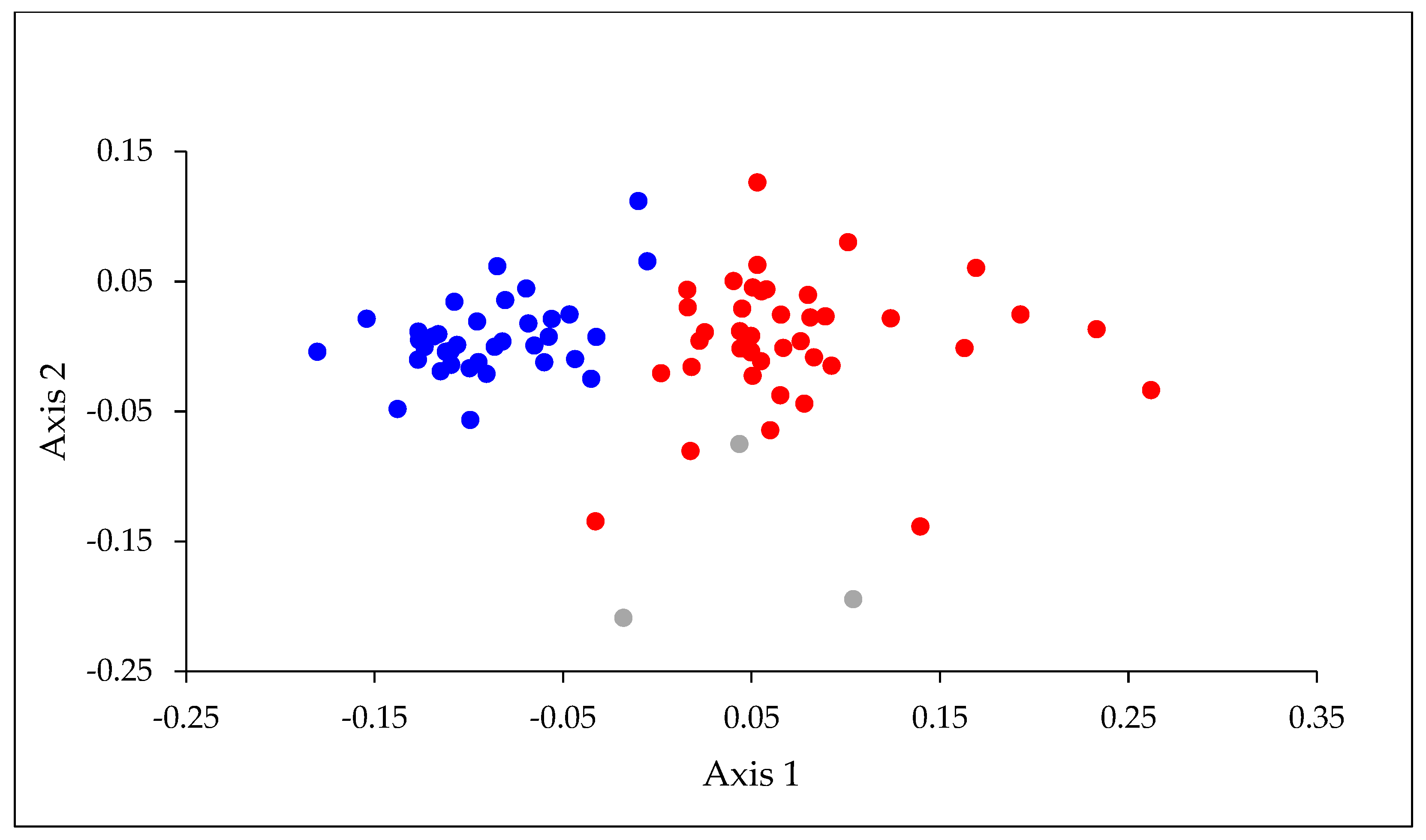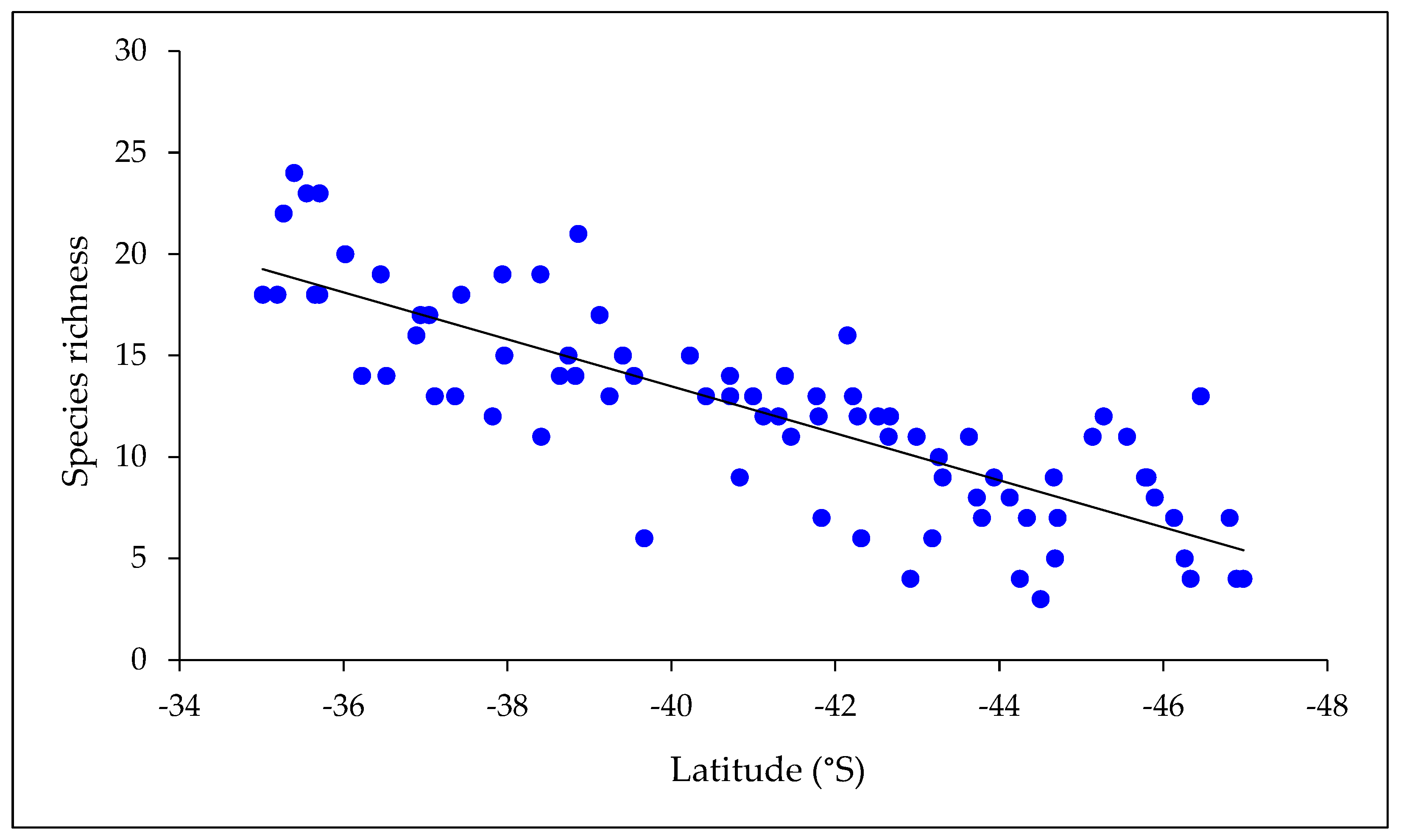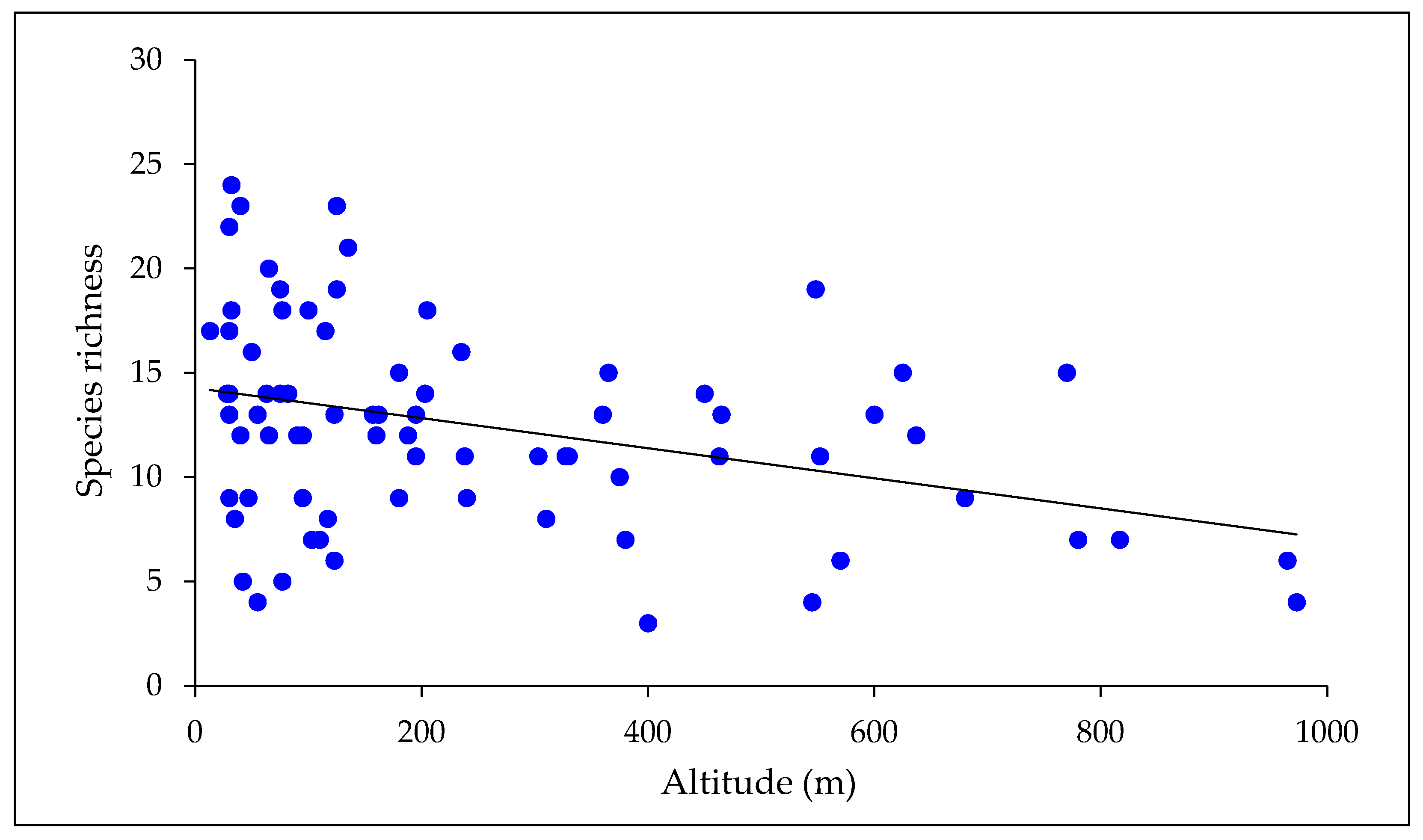Species Richness and Similarity of New Zealand Mayfly Communities (Ephemeroptera) Decline with Increasing Latitude and Altitude
Abstract
Simple Summary
Abstract
1. Introduction
2. Materials and Methods
2.1. Study Sites
2.2. Survey Procedure
2.3. Measurement of Habitat Variables
2.4. Identification of Mayflies
2.5. Statistical Analyses
3. Results
3.1. Distribution of Species
3.2. Relationships with Latitude and Altitude
3.3. Mount Taranaki Altitudinal Surveys
4. Discussion
Author Contributions
Funding
Data Availability Statement
Acknowledgments
Conflicts of Interest
Appendix A
| Species | Zones | ||||||
|---|---|---|---|---|---|---|---|
| 1 | 2 | 3 | 4 | 5 | 6 | 7 | |
| Suborder Furcatergalia | |||||||
| Family Ichthybotidae | |||||||
| Ichthybotus bicolor Tillyard, 1923 | x | x | x | ||||
| Ichthybotus hudsoni (McLachlan, 1894) | x | x | x | ||||
| Family Leptophlebiidae | |||||||
| Acanthophlebia cruentata (Hudson, 1904) | x | x | x | x | |||
| Arachnocolus phillipsi Towns & Peters, 1979 | x | x | x | ||||
| Atalophlebioides cromwelli (Phillips, 1930) | x | x | x | x | x | x | |
| Austroclima jollyae Towns & Peters, 1979 | x | x | x | x | x | x | |
| Austroclima sepia (Phillips, 1930) | x | x | x | x | x | x | x |
| Austronella planulata (Towns, 1983) | x | x | x | ||||
| Deleatidium acerbum Hitchings & Hitchings, 2016 | x | ||||||
| Deleatidium angustum Towns & Peters, 1996 | x | x | x | x | |||
| Deleatidium atricolor Hitchings, 2009 | x | x | x | ||||
| Deleatidium autumnale Phillips, 1930 | x | x | x | x | x | ||
| Deleatidium cerinum Phillips, 1930 | x | x | x | x | x | ||
| Deleatidium cornutum Towns & Peters, 1996 | x | ||||||
| Deleatidium fumosum Phillips, 1930 | x | x | x | x | x | x | |
| Deleatidium kiwa Hitchings, 2010 | x | x | |||||
| Deleatidium lillii Eaton, 1899 | x | x | x | x | x | x | |
| Deleatidium magnum Towns & Peters, 1996 | x | ||||||
| Deleatidium myzobranchia Phillips, 1930 | x | x | x | x | x | x | x |
| Deleatidium patricki Hitchings, 2008 | x | ||||||
| Deleatidium townsi Hitchings, 2009 | x | x | x | ||||
| Deleatidium vernale Phillips, 1930 | x | x | x | x | x | ||
| Deleatidium wardorum Hitchings, 2010 | x | x | x | ||||
| Deleatidium “lyellensis” | x | ||||||
| Deleatidium “rakiura” | x | ||||||
| Isothraulus abditus Towns & Peters, 1979 | x | x | x | ||||
| Mauiulus aquilus Towns & Peters, 1996 | x | ||||||
| Mauiulus luma Towns & Peters, 1979 | x | x | x | ||||
| Neozephlebia scita (Walker, 1853) | x | x | x | x | x | x | x |
| Tepakia caligata Towns & Peters, 1996 | x | x | |||||
| Zephlebia borealis (Phillips, 1930) | x | x | x | x | |||
| Zephlebia dentata (Eaton, 1871) | x | x | x | x | |||
| Zephlebia inconspicua Towns, 1983 | x | x | |||||
| Zephlebia nebulosa Towns & Peters, 1996 | x | x | |||||
| Zephlebia pirongia Towns & Peters, 1996 | x | ||||||
| Zephlebia spectabilis Towns, 1983 | x | x | x | x | x | x | x |
| Zephlebia tuberculata Towns & Peters, 1996 | x | x | x | ||||
| Zephlebia versicolor (Eaton, 1899) | x | x | x | x | |||
| Zephlebia “aff. pirongia sp. 1” | x | ||||||
| Zephlebia “sp. 1” | x | x | |||||
| Suborder Pisciforma | |||||||
| Family Ameletopsidae | |||||||
| Ameletopsis perscitus (Eaton, 1899) | x | x | x | x | x | x | x |
| Family Nesameletidae | |||||||
| Nesameletus austrinus Hitchings & Staniczek, 2003 | x | x | x | ||||
| Nesameletus flavitinctus (Tillyard, 1923) | x | x | x | x | x | ||
| Nesameletus murihiku Hitchings & Staniczek, 2003 | x | ||||||
| Nesameletus ornatus (Eaton, 1883) | x | x | x | x | x | x | |
| Nesameletus “Fiordland” | x | x | |||||
| Family Oniscigastridae | |||||||
| Oniscigaster distans Eaton, 1899 | x | x | x | x | |||
| Oniscigaster wakefieldi McLachlan, 1873 | x | x | x | x | x | ||
| Family Rallidentidae | |||||||
| Rallidens mcfarlanei Penniket, 1966 | x | x | x | ||||
| Rallidens platydontis Staniczek & Hitchings, 2014 | x | x | |||||
| Family Siphlaenigmatidae | |||||||
| Siphlaenigma janae Penniket, 1962 | x | x | x | x | |||
| Suborder Setisura | |||||||
| Family Coloburiscidae | |||||||
| Coloburiscus humeralis (Walker, 1853) | x | x | x | x | x | x | x |
| Species | 120 | 280 | 420 | 600 | 730 | 880 | 1100 |
|---|---|---|---|---|---|---|---|
| Acanthophlebia cruentata | x | x | x | x | x | ||
| Ameletopsis perscitus | x | x | x | x | x | x | |
| Arachnocolus phillipsi | x | ||||||
| Austroclima jollyae | x | ||||||
| Austroclima sepia | x | x | x | ||||
| Coloburiscus humeralis | x | x | x | x | x | ||
| Deleatidium angustum | x | ||||||
| Deleatidium autumnale | x | x | x | ||||
| Deleatidium fumosum | x | x | x | x | x | x | x |
| Deleatidium magnum | x | x | x | ||||
| Deleatidium myzobranchia | x | x | x | x | x | x | |
| Ichthybotus hudsoni | x | x | |||||
| Neozephlebia scita | x | x | x | x | x | ||
| Nesameletus flavitinctus | x | x | x | x | x | ||
| Nesameletus ornatus | x | x | |||||
| Oniscigaster distans | x | x | |||||
| Rallidens mcfarlanei | x | ||||||
| Zephlebia borealis | x | x | x | x | |||
| Zephlebia dentata | x | x | x | x | |||
| Zephlebia spectabilis | x | x | x | x | x | ||
| Zephlebia versicolor | x | x | x | x | x | x |
References
- Parmesan, C.; Yohe, G. A globally coherent fingerprint of climate change impacts across natural systems. Nature 2003, 421, 37–42. [Google Scholar] [CrossRef] [PubMed]
- Jenkins, K.M.; Kingsford, R.T.; Closs, G.P.; Wolfenden, B.J.; Matthaei, C.D.; Hay, S.E. Climate change and freshwater ecosystems in Oceania: An assessment of vulnerability and adaptation opportunities. Pac. Conserv. Biol. 2011, 17, 201–219. [Google Scholar] [CrossRef]
- Hillebrand, H. On the generality of the latitudinal diversity gradient. Am. Nat. 2004, 163, 192–211. [Google Scholar] [CrossRef] [PubMed]
- Lawrence, E.R.; Fraser, D.J. Latitudinal biodiversity gradients at three levels: Linking species richness, population richness and genetic diversity. Glob. Ecol. Biogeogr. 2020, 29, 770–788. [Google Scholar] [CrossRef]
- Soininen, J.; McDonald, R.; Hillebrand, H. The distance decay of similarity in ecological communities. Ecography 2007, 30, 3–12. [Google Scholar] [CrossRef]
- Fine, P.V.A. Ecological and evolutionary drivers of geographic variation in species diversity. Annu. Rev. Ecol. Evol. Syst. 2015, 46, 369–392. [Google Scholar] [CrossRef]
- Vinson, M.R.; Hawkins, C.P. Broad-scale geographical patterns in local stream insect genera richness. Ecography 2003, 26, 751–767. [Google Scholar] [CrossRef]
- Pearson, R.G.; Boyero, L. Gradients in regional diversity of freshwater taxa. J. N. Am. Benthol. Soc. 2009, 28, 504–514. [Google Scholar] [CrossRef]
- Buckley, L.B.; Jetz, W. Linking global turnover of species and environments. Proc. Natl. Acad. Sci. USA 2008, 105, 17836–17841. [Google Scholar] [CrossRef]
- Langenheder, S.; Székely, A.J. Species sorting and neutral processes are both important during the initial assembly of bacterial communities. ISME J. 2011, 5, 1086–1094. [Google Scholar] [CrossRef]
- Tonkin, J.D.; Death, R.G.; Muotka, T.; Astorga, A.; Lytle, D.A. Do latitudinal gradients exist in New Zealand stream invertebrate metacommunities? Peer J. 2018, 6, e4898. [Google Scholar] [CrossRef]
- Harding, J.S.; Benfield, E.F.; Bolstad, P.V.; Helfman, G.S.; Jones, E.B.D. Stream biodiversity: The ghost of land use past. Proc. Natl. Acad. Sci. USA 1998, 95, 14843–14847. [Google Scholar] [CrossRef] [PubMed]
- Shimano, Y.; Juen, L.; Salles, F.F.; Nogueira, D.S.; Cabette, H.S.R. Environmental and spatial processes determining Ephemeroptera (Insecta) structures in tropical streams. Int. J. Limnol. 2013, 49, 31–41. [Google Scholar] [CrossRef]
- Ormerod, S.J.; Rundle, S.D.; Wilkinson, S.M.; Daly, G.P.; Dale, K.M.; Juttner, I. Altitudinal trends in the diatoms, bryophytes, macroinvertebrates and fish of a Nepalese river system. Freshw. Biol. 1994, 32, 309–322. [Google Scholar] [CrossRef]
- Suren, A.M. Macroinvertebrate communities of streams in western Nepal: Effects of altitude and land use. Freshw. Biol. 1994, 32, 323–336. [Google Scholar] [CrossRef]
- Jacobsen, D.; Dangles, O. Ecology of High Altitude Waters; Oxford University Press: New York, NY, USA, 2017. [Google Scholar]
- Peters, M.K.; Hemp, A.; Appelhans, T.; Behler, C.; Classen, A.; Detsch, F.; Ensslin, A.; Ferger, S.W.; Frederiksen, S.B.; Gebert, F.; et al. Predictors of elevational biodiversity gradients change from single taxa to the multi-taxa community level. Nat. Commun. 2016, 7, 13736. [Google Scholar] [CrossRef] [PubMed]
- Ward, J.V. Aquatic Insect Ecology 1. Biology and Habitat; Wiley: New York, NY, USA, 1992. [Google Scholar]
- Hynes, H.B.N. The Ecology of Running Waters; University of Toronto Press: Toronto, ON, Canada, 1970. [Google Scholar]
- Norton, D.A. A multivariate technique for estimating New Zealand temperature normals. Weather. Clim. 1985, 5, 64–74. [Google Scholar] [CrossRef]
- Hodkinson, I.D. Terrestrial insects along elevation gradients: Species and community responses to altitude. Biol. Rev. 2005, 80, 489–513. [Google Scholar] [CrossRef] [PubMed]
- Pohe, S.R. An annotated checklist of New Zealand mayflies (Ephemeroptera), 2018. N. Z. Nat. Sci. 2018, 43, 1–20. [Google Scholar]
- Hitchings, T.R.; Hitchings, T.R. Deleatidium kakahu, new species of Deleatidium (Ephemeroptera: Leptophlebiidae) from New Zealand. Rec. Canterb. Mus. 2021, 35, 253–259. [Google Scholar]
- Hitchings, T.; Hitchings, T.; Ridden, J. Nesameletus staniczeki, a new species of Nesameletus (Ephemeroptera: Nesameletidae) from New Zealand. Rec. Canterb. Mus. 2022, 36, 169–177. [Google Scholar]
- Edmunds, G.F. Biogeography and evolution of Ephemeroptera. Annu. Rev. Entomol. 1972, 17, 21–42. [Google Scholar] [CrossRef]
- O’Donnell, B.C.; Jockusch, E.L. Phylogenetic relationships of leptophlebiid mayflies as inferred by histone H3 and 28S ribosomal DNA. Syst. Entomol. 2008, 33, 651–667. [Google Scholar] [CrossRef]
- Gibbs, G. Ghosts of Gondwana. The History of Life in New Zealand; Potton & Burton: Nelson, New Zealand, 2016. [Google Scholar]
- Towns, D.R.; Peters, W.L. Leptophlebiidae (Insecta: Ephemeroptera); Fauna of New Zealand 36; Manaaki Whenua Press: Lincoln, New Zealand, 1996. [Google Scholar]
- Luyendyk, B.P. Hypothesis for Cretaceous rifting of east Gondwana caused by subducted slab capture. Geology 1995, 23, 373–376. [Google Scholar] [CrossRef]
- Hitchings, T.R.; Hitchings, T.R.; Shaw, M.D. A revision of the distribution maps and database of New Zealand mayflies (Ephemeroptera) at Canterbury Museum. Rec. Canterb. Mus. 2015, 29, 5–34. [Google Scholar]
- Leathwick, J.R.; West, D.; Gerbeaux, P.; Kelly, D.; Robertson, H.; Brown, D.; Chadderton, W.L.; Ausseil, A.-G. Freshwater Ecosystems of New Zealand (FENZ) Geodatabase Version One—August 2010 User Guide; Department of Conservation: Wellington, New Zealand, 2010. [Google Scholar]
- Pohe, S.R. Macroecology of New Zealand Ephemeroptera. Ph.D. Thesis, University of Canterbury, Christchurch, New Zealand, 2019, unpublished. [Google Scholar]
- Neall, V.E.; Stewart, R.B.; Smith, I.E.M. History and petrology of the Taranaki volcanoes. In Late Cenozoic Volcanism in New Zealand; Smith, I.E.D., Ed.; Royal Society of New Zealand Bulletin 23; Royal Society of New Zealand: Wellington, New Zealand, 1986; pp. 251–263. [Google Scholar]
- Pohe, S.R.; Winterbourn, M.J.; Harding, J.S. Comparison of fluorescent lights with differing spectral properties on catches of adult aquatic and terrestrial insects. N. Z. Entomol. 2018, 41, 1–11. [Google Scholar] [CrossRef]
- Norrie, P.H. The Flight Activity of Ephemeroptera and Trichoptera in a Waitakere Stream. Master’s Thesis, The University of Auckland, Auckland, New Zealand, 1969, unpublished. [Google Scholar]
- Ward, J.B.; Henderson, I.M.; Patrick, B.H.; Norrie, P.H. Seasonality, sex ratios and arrival pattern of some New Zealand caddis (Trichoptera) to light-traps. Aquat. Insects 1996, 18, 157–174. [Google Scholar] [CrossRef]
- Wolman, M.G. A method of sampling coarse river-bed material. EOS Trans. Am. Geophys. Union 1954, 35, 951–956. [Google Scholar]
- Indicators: Conductivity. EPA United States Environmental Protection Agency. Available online: https://www.epa.gov/national-aquatic-resource-surveys/indicators-conductivity (accessed on 12 September 2024).
- Pfankuch, D.J. Stream Reach Inventory and Channel Stability Evaluation; United States Department of Agriculture Forest Service, Region 1: Missoula, MT, USA, 1975.
- Phillips, J.S. A revision of New Zealand Ephemeroptera. Trans. Proc. N. Z. Inst. 1930, 61, 271–390. [Google Scholar]
- Phillips, J.S. Studies of New Zealand mayfly nymphs. Trans. Roy. Entomol. Soc. Lond. 1931, 79, 399–422. [Google Scholar] [CrossRef]
- Hitchings, T.R.; Staniczek, A.H. Nesameletidae (Insecta: Ephemeroptera); Fauna of New Zealand 46; Manaaki Whenua Press: Lincoln, New Zealand, 2003. [Google Scholar]
- Winterbourn, M.J.; Gregson, K.L.D.; Dolphin, C.H. Guide to the Aquatic Insects of New Zealand, 4th ed.; Bulletin (Entomological Society of New Zealand) 14; Entomological Society of New Zealand: Auckland, New Zealand, 2006. [Google Scholar]
- Stout, J.; Vandermeer, J. Comparison of species richness for stream-inhabiting insects in tropical and mid-latitude streams. Am. Nat. 1975, 109, 263–280. [Google Scholar] [CrossRef]
- Astorga, A.; Death, R.; Death, F.; Paavola, R.; Chakraborty, M.; Muotka, T. Habitat heterogeneity drives the geographical distribution of beta diversity: The case of New Zealand stream invertebrates. Ecol. Evol. 2014, 4, 2693–2702. [Google Scholar] [CrossRef] [PubMed]
- Clarke, K.R. Non-parametric multivariate analyses of changes in community structure. Aust. J. Ecol. 1993, 18, 117–143. [Google Scholar] [CrossRef]
- McCune, B.; Mefford, M.J. PC-ORD. Multivariate Analysis of Ecological Data; MjM Software: Gleneden Beach, OR, USA, 2011. [Google Scholar]
- Hammer, Ø.; Harper, D.A.T.; Ryan, P.D. PAST: Paleontological statistics software package for education and data analysis. Palaeontol. Electron. 2001, 4, 1–9. [Google Scholar]
- Lake, P.S.; Schreiber, E.S.G.; Milne, B.J.; Pearson, R.G. Species richness in streams: Patterns over time, with stream size and with latitude. Verh. Internat. Verein. Limnol. 1994, 25, 1822–1826. [Google Scholar] [CrossRef]
- Boulton, A.J.; Boyero, L.; Covich, A.P.; Dobson, M.; Lake, S.; Pearson, R. Are tropical streams ecologically different from temperate streams? In Aquatic Ecosystems: Tropical Stream Ecology; Dudgeon, D., Cressa, C., Eds.; Academic Press: London, UK, 2008; pp. 257–284. [Google Scholar]
- Beketov, M.A. Community structure of Ephemeroptera in Siberian streams. Entomol. Sci. 2008, 11, 289–299. [Google Scholar] [CrossRef]
- Maltchik, L.; Stenert, C.; Spies, M.R.; Siegloch, A.E. Diversity and distribution of Ephemeroptera and Trichoptera in southern Brazil wetlands. J. Kans. Entomol. 2009, 82, 160–173. [Google Scholar] [CrossRef]
- McGlone, M.S.; Richardson, S.J.; Jordan, G.J. Comparative biogeography of New Zealand trees: Species richness, height, leaf traits and range sizes. N. Z. J. Ecol. 2010, 34, 137–151. [Google Scholar]
- Spencer, H.G.; Brook, F.J.; Kennedy, M. Phylogeography of kauri snails and their allies from Northland, New Zealand (Mollusca: Gastropoda: Rhytididae: Paryphantinae). Mol. Phylogenet. Evol. 2006, 38, 835–842. [Google Scholar] [CrossRef] [PubMed]
- Ball, O.J.-P.; Webber, W.R.; Shepherd, L.D. New species and phylogeny of landhoppers in the genus Waematau Duncan, 1994 (Crustacea: Amphipoda: Talitridae) from northern New Zealand. Zootaxa 2017, 4306, 151–207. [Google Scholar] [CrossRef]
- Taylor-Smith, B.; Morgan-Richards, M.; Trewick, S.A. Patterns of regional endemism among New Zealand invertebrates. N. Z. J. Zool. 2020, 47, 1–19. [Google Scholar] [CrossRef]
- Smith, P.J.; Collier, K.J. Allozyme diversity and population genetic structure of the caddisfly Orthopsyche fimbriata and the mayfly Acanthophlebia cruentata in New Zealand streams. Freshw. Biol. 2001, 46, 795–805. [Google Scholar] [CrossRef]
- Smith, P.J.; McVeagh, S.M.; Collier, K.J. Genetic diversity and historical population structure in the New Zealand mayfly Acanthophlebia cruentata. Freshw. Biol. 2006, 51, 12–24. [Google Scholar] [CrossRef]
- Pohe, S.R.; Winterbourn, M.J.; Goldstien, S.J.; Harding, J.S. Distribution, body size, genetic structure and conservation of Siphlaenigma janae (Insecta: Ephemeroptera). N. Z. J. Zool. 2018, 45, 154–170. [Google Scholar] [CrossRef]
- Trewick, S.A.; Bland, K.J. Fire and slice: Palaeogeography for biogeography at New Zealand’s North Island/South Island juncture. J. Roy. Soc. N. Z. 2012, 42, 153–183. [Google Scholar] [CrossRef]
- Hitchings, T.R. The post glacial distribution of New Zealand mayflies. In International Advances in the Ecology, Zoogeography, and Systematics of Mayflies and Stoneflies; Hauer, F.R., Stanford, J.A., Newell, R.L., Eds.; University of California Press: Berkeley, CA, USA, 2008; pp. 89–101. [Google Scholar]
- Hitchings, T.R. Leptophlebiidae (Ephemeroptera) of the alpine region of the Southern Alps. Aquat. Insects 2009, 31 (Suppl. S1), 595–601. [Google Scholar] [CrossRef]
- Craig, D.A.; Craig, R.E.G.; Crosby, T.K. Simuliidae (Insecta: Diptera); Fauna of New Zealand 68; Manaaki Whenua Press: Lincoln, New Zealand, 2012. [Google Scholar]
- McCulloch, G.A.; Wallis, G.P.; Waters, J.M. Onset of glaciation drove simultaneous vicariant isolation of alpine insects in New Zealand. Evolution 2010, 64, 2033–2043. [Google Scholar] [CrossRef]
- McLellan, I.D. Endemism and biogeography of New Zealand Plecoptera (Insecta). Illiesia 2006, 2, 15–23. [Google Scholar]
- Winterbourn, M.J. New Zealand mountain stream communities: Stable yet disturbed? In Evolutionary Ecology of Freshwater Animals: Concepts and Case Studies; Streit, B., Städler, T., Lively, C.M., Eds.; Birkhäuser Verlag: Basel, Switzerland, 1997; pp. 31–54. [Google Scholar]
- Hildrew, A.G.; Giller, P.S. The Biology and Ecology of Streams and Rivers; Oxford University Press: Oxford, UK, 2023. [Google Scholar]
- Mullan, B.; Wratt, D.; Dean, S.; Hollis, M.; Allan, S.; Williams, T.; Kenny, G. Climate Change Effects and Impacts Assessment: A Guidance Manual for Local Government in New Zealand, 2nd ed.; Ministry for the Environment: Wellington, NZ, USA, 2008. [Google Scholar]
- McGlone, M.; Walker, S. Potential Effects of Climate Change on New Zealand’s Terrestrial Biodiversity and Policy Recommendations for Mitigation, Adaptation and Research; Science for Conservation 312, Department of Conservation: Wellington, NZ, USA, 2011. [Google Scholar]
- Winterbourn, M.J.; Cadbury, S.; Ilg, C.; Milner, A.M. Mayfly production in a New Zealand glacial stream and the potential effect of climate change. Hydrobiologia 2008, 603, 211–219. [Google Scholar] [CrossRef]
- Ogden, T.H.; Whiting, M.F. Phylogeny of Ephemeroptera (mayflies) based on molecular evidence. Mol. Phylogenet. Evol. 2005, 37, 625–643. [Google Scholar] [CrossRef] [PubMed]




| Species | Locations (%) |
|---|---|
| Coloburiscus humeralis | 88 |
| Ameletopsis perscitus | 70 |
| Neozephlebia scita | 69 |
| Deleatidium myzobranchia | 62 |
| Deleatidium fumosum | 60 |
| Nesameletus ornatus | 57 |
| Zephlebia spectabilis | 51 |
| Austroclima sepia | 47 |
| Zephlebia versicolor | 46 |
| Acanthophlebia cruentata | 41 |
| Zephlebia dentata | 41 |
| Species | Average | Numbers of Locations Present (%) | |
|---|---|---|---|
| Dissimilarity | North Island | South Island | |
| Acanthophlebia cruentata | 3.73 | 91.7 | 0 |
| Zephlebia dentata | 3.66 | 91.7 | 0 |
| Zephlebia versicolor | 3.25 | 88.9 | 11.9 |
| Zephlebia borealis | 3.03 | 77.8 | 0 |
| Austroclima sepia | 2.96 | 83.3 | 14.3 |
| Ichthybotus hudsoni | 2.79 | 72.2 | 0 |
| Altitude | Latitude | Stream Width | Canopy Cover | Stone Size | Pfankuch Index | Conductivity | Water Temp | |
|---|---|---|---|---|---|---|---|---|
| Axis 1 | 0.34 * | 0.79 *** | 0.21 | −0.41 ** | 0.28 | −0.02 | −0.46 *** | −0.62 *** |
| Axis 2 | 0.29 * | −0.20 | 0.29 * | −0.34 * | 0.32 * | −0.16 | −0.10 | 0.21 |
| Zones | 1 | 2 | 3 | 4 | 5 | 6 |
|---|---|---|---|---|---|---|
| 1 | 1.00 | 0.89 | 0.93 | 0.65 | 0.52 | 0.48 |
| 2 | 1.00 | 0.87 | 0.63 | 0.49 | 0.45 | |
| 3 | 1.00 | 0.69 | 0.56 | 0.53 | ||
| 4 | 1.00 | 0.80 | 0.76 | |||
| 5 | 1.00 | 0.83 | ||||
| 6 | 1.00 |
| Altitude (m a. s. l.) | |||||||||
|---|---|---|---|---|---|---|---|---|---|
| 120 | 280 | 420 | 600 | 730 | 880 | 1100 | r | p | |
| Mean air temperature (°C) | |||||||||
| December | 14.0 | 11.8 | 12.6 | 12.0 | 11.1 | 8.9 | 8.0 | −0.94 | 0.002 |
| February | 18.1 | 17.7 | 16.5 | 15.2 | 14.7 | 15.7 | 13.7 | −0.93 | 0.003 |
| Number of species | |||||||||
| December | 10 | 7 | 11 | 11 | 10 | 5 | 2 | −0.67 | 0.11 |
| February | 13 | 11 | 13 | 8 | 9 | 8 | 4 | −0.91 | 0.004 |
| Total | 15 | 12 | 13 | 13 | 12 | 8 | 5 | −0.89 | 0.007 |
| Similarity (D) cf. 120 m site | - | 0.74 | 0.71 | 0.86 | 0.74 | 0.35 | 0.10 | ||
Disclaimer/Publisher’s Note: The statements, opinions and data contained in all publications are solely those of the individual author(s) and contributor(s) and not of MDPI and/or the editor(s). MDPI and/or the editor(s) disclaim responsibility for any injury to people or property resulting from any ideas, methods, instructions or products referred to in the content. |
© 2024 by the authors. Licensee MDPI, Basel, Switzerland. This article is an open access article distributed under the terms and conditions of the Creative Commons Attribution (CC BY) license (https://creativecommons.org/licenses/by/4.0/).
Share and Cite
Pohe, S.R.; Winterbourn, M.J.; Harding, J.S. Species Richness and Similarity of New Zealand Mayfly Communities (Ephemeroptera) Decline with Increasing Latitude and Altitude. Insects 2024, 15, 757. https://doi.org/10.3390/insects15100757
Pohe SR, Winterbourn MJ, Harding JS. Species Richness and Similarity of New Zealand Mayfly Communities (Ephemeroptera) Decline with Increasing Latitude and Altitude. Insects. 2024; 15(10):757. https://doi.org/10.3390/insects15100757
Chicago/Turabian StylePohe, Stephen R., Michael J. Winterbourn, and Jon S. Harding. 2024. "Species Richness and Similarity of New Zealand Mayfly Communities (Ephemeroptera) Decline with Increasing Latitude and Altitude" Insects 15, no. 10: 757. https://doi.org/10.3390/insects15100757
APA StylePohe, S. R., Winterbourn, M. J., & Harding, J. S. (2024). Species Richness and Similarity of New Zealand Mayfly Communities (Ephemeroptera) Decline with Increasing Latitude and Altitude. Insects, 15(10), 757. https://doi.org/10.3390/insects15100757






